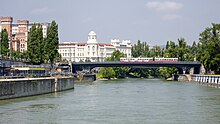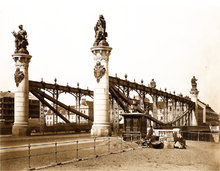Augarten Bridge


The Augartenbrücke crosses the Danube Canal in Vienna and connects the 9th, Alsergrund , and the 1st district, Innere Stadt , both on the right bank of the river, with the 2nd district, Leopoldstadt , on the left bank. There has been a bridge here since 1782.
location
The Augartenbrücke connects Maria-Theresien-Straße in the 1st / 9th district and Untere Augartenstraße in the 2nd district to form a continuous street that can be used in one-way traffic towards the 2nd district. (Since 1983 there has been a counterpart to the 9th district road, Rembrandtstraße – Rossauer Brücke –Türkenstraße.) At the bridgeheads are the roads 9th, Rossauer Lände / 1., Franz-Josefs-Kai (one-way south) and Obere Connected to Donaustraße (2nd district, one-way north).
At the corner of Maria-Theresien-Straße, the Rossauer Kaserne is located on the north side in the 9th district next to the bridge on the Rossauer Lände , on the south side in the 1st district the northernmost block of the Franz-Josefs-Kai , outside the Ringstraße .
The bridge is used in both directions by the tram in the middle of the bridge; to the north of it there are since 1983 the lanes for turning left into Obere Donaustraße (formerly traffic in the 1st / 9th district), south of the tracks the lanes for driving straight ahead into Untere Augartenstraße. Under the bridge in the 1st / 9th district between the underground stations Rossauer Lände north and Schottenring south of the bridge, the Danube Canal runs along the U4 underground line at the level of the Vorkais, the successor to the light rail system that opened here in 1901 .
history
After the Augarten was opened to the general public by Joseph II , the Neue Gasse (today Untere Augartenstraße) was opened in 1775 and in 1782 a connection with the Rossau via the "Neue Brücke", a wooden yoke bridge, over the arm of Vienna at that time, today's Danube Canal, created. During the war with Napoleon's troops , the New Bridge was burned down for tactical reasons in 1809, but restored that same year. In 1829 a new bridge was built in the same place.
This Augarten bridge was replaced in 1872/73 by the bridge built by the French Compagnie de Fives-Lille from welded iron of Belgian origin, an iron bridge with suspension trusses and support chains as well as a wooden deck and wooden decking. The opening took place on June 6, 1873 during the Vienna World's Fair . The four granite portal pillars carried allegorical bronze figures (painting, poetry, industry, astronomy).
The reference in the literature that the bridge has now been baptized with the name Maria-Theresien-Brücke is likely to be erroneous. A newspaper report from the day after the name was decided on says that the name Augartenbrücke was chosen by the town council on November 29, 1872, chaired by Mayor Felder . Furthermore, the bridge can be found on city maps from the years 1873, 1880 and 1890, as it was in 1840 as the Augarten Bridge . In Arthur Schnitzler's drama Reigen , manuscript 1896/1897, first printed in 1900, the first scene, The Whore and the Soldier , is set here: Late in the evening. At the Augarten Bridge. This bridge name also appears on a postcard photographed in 1904.
As the bridge, which opened in 1873, was no longer able to cope with the increased traffic, traffic restrictions had to be implemented in the last few years of its existence for safety reasons.
In September 1927, the Vienna City Planning Department under city planning director Franz Musil (1884–1966) decided to build the new Augarten Bridge. In this context, consideration was given to relocating the Augarten Bridge from Maria-Theresien-Strasse (part of the route known as “laden street” for trucks that were not allowed to drive on Vienna's Ringstrasse ) to the Schottenring ; In the interests of truck traffic, however, these considerations were not pursued any further.
In order to enable the Danube Canal to be crossed during the construction work, a replacement bridge was built by the construction company Waagner-Biró , the capacity of which corresponded to that of the Friedensbrücke . (Originally the predecessor of the Friedensbrücke, the dismantled former Brigittabrücke, was supposed to take over this task, but was used in 1927 at the location of the later Freudenauer Hafenbrücke .) The auxiliary bridge was opened to traffic in October 1928.
The Augarten Bridge was rebuilt from 1929 to 1931 based on a design by Hubert Gessner . The appearance of the bridge was now simple, it received characteristic lighting. The new bridge was built exactly on the axis of its predecessor. It had four lanes, two tram tracks and two sidewalks. The opening took place on July 5, 1931 in the presence of Federal President Wilhelm Miklas and Federal Minister for Trade and Transport Eduard Heinl .
During the Battle of Vienna in April 1945, the bridge was destroyed when the German units withdrew. However, it was the first Danube Canal bridge to be restored after the Second World War and was ceremonially opened to traffic on January 12, 1946.
The bridge has played a role in tram traffic since the steam tramway opened in 1886 from Obere Donaustraße to Floridsdorf was replaced in 1910 by the electric tram , which started in 1911 from the terminus at what was then the Schottenring metro station in the 1st district is operated from. The last routes over the bridge were lines 331 to Stammersdorf and 132 to Strebersdorf , known as the 31 and 32 since 1982. In the course of the extension of the U6 underground line to Floridsdorf, line 32 was dropped in 1996.
Since 1995, the Flex music venue has been located at the level of the foreshore of the Danube Canal, downstream next to the bridge in the 1st district .
District boundaries
Since the area between the Danube Canal and the Danube and the suburbs within the line wall were incorporated into Vienna in 1850, the bridge has been located at this location in the urban area of Vienna. The border between the 2nd district on the one hand and the 1st and 9th district on the other runs along the right, western bank edge between the Vorkai and the Danube Canal, so that the bridge itself largely belongs to the 2nd district. The bridgehead on the right, western bank and the fore quay below are mostly part of the 9th district. The stairs from the bridge to the right front quay or to the "Flex" form the northernmost point of the 1st district.
literature
- Journal of the Austrian Association of Engineers and Architects , Vienna 1930, ZDB -ID 2534647-7 .
- Rudolf Schuhmann: Technology and Economy. The new Augarten Bridge. In: Neue Freie Presse , Morgenblatt, No. 23998/1931, July 7, 1931, p. 9. (Online at ANNO ). .
Web links
- The Augarten Bridge
- Friedrich Paul: The Augarten Bridge over the Vienna Danube Canal. In: Allgemeine Bauzeitung , year 1881, volume 46.1881, p. 68, center left, as well as panels 50–53. (Online at ANNO ). .
- Augarten Bridge over the Danube Canal in Vienna. In: Allgemeine Bauzeitung , year 1881, volume 46.1881, p. Plates 50–53. (Online at ANNO ). .
- Augarten Bridge. In: Structurae
Individual evidence
- ^ Daily newspaper Neue Freie Presse , Vienna, No. 2971 of November 30, 1872, p. 6, section Communal-Zeitung
- ^ Sylvia Mattl-Wurm, Alfred Pfoser (ed.): The measurement of Vienna. Lehmann's address books 1859–1942, Vienna library in the town hall , Metroverlag, Vienna 2011, ISBN 978-3-99300-029-5 , pp. 84, 300, 310, 314
- ^ Structurae, International Gallery and Database of Civil Engineering
- ^ (Franz Musil): The new Augarten Bridge. In: Neue Freie Presse , Abendblatt, No. 22641/1927, September 28, 1927, p. 5, top left. (Online at ANNO ). .
- ↑ Two opening ceremonies on the radio. In: Radio Wien , No. 40/1931 (Volume VII), July 3, 1931, p. 3. (Online at ANNO ). .
- ↑ (caption :) On July 5th, in the presence of (...). In: Wiener Bilder , No. 28/1931 (XXXVI. Year), July 12, 1931, p. 4, top left. (Online at ANNO ). .
Coordinates: 48 ° 13 ′ 8 ″ N , 16 ° 22 ′ 13 ″ E

